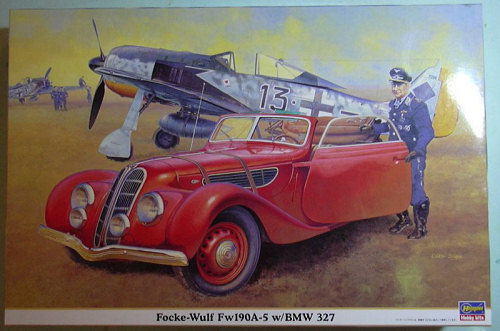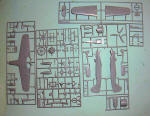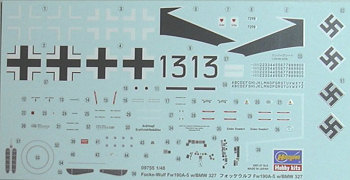
| KIT: | Hasegawa 1/48 FW-190A-5 'Priller Special' |
| KIT #: | 09755 |
| PRICE: | 3,600 yen at www.hlj.com |
| DECALS: | One option |
| REVIEWER: | Tom Cleaver |
| NOTES: | Includes BMW 327 Coupe and Priller figure |

| HISTORY |
Born on July 27, 1915 in Ingolstadt, Bavaria, Josef “Pips” Priller entered the German Army in 1935 as a Fahnenjunker (Cadet), serving with Infanterieregiment 19. Promoted to Oberfähnrich (Senior Cadet), Priller transferred to the Luftwaffe and commenced flight training at Salzwedel in October, 1936.
Graduating from training in April 1937, Priller was assigned to I./JG 135,which was redesignated I/JG 233 in November 1938, and finally designated I/JG 51 on May 1, 1939. Priller was transferred tp I/JG71 that July; the united being redesignated II/JG 51 on October 1, when Priller was promoted to Staffelkapitän of 6./JG 51. Priller began his score against the RAF on May 28, 1940 over Dunkirk, and claimed six victories during the French campaign, including his first Spitfire on June 25, near Desvres. By the end of August, he claimed 15 victories. Promoted to Oberleutnant, Priller claimed his 20th on October 17, 1940 and was awarded of the Ritterkreuz two days later.
Priller began his long career with JG 26 on November 20, 1940, when he was transferred as Staffelkapitän to 1./JG 26, replacing Oberleutnant Eberhard Henrici, who had been lost over the Channel on November 17. Following the unit’s rest back in Germany in January and February, 1941, Priller began adding to his score with a remarkable run between June 16 and July 11, during which time he shot down 19 RAF aircraft, including 17 Spitfires. On July 14, Priller scored his 40th victory and became the 28th German soldier awarded the Eichenlaub on October 19, for 41 victories. Promoted by now to Hauptmann, Priller was promoted Gruppenkommandeur of III/JG 26 on December 6, 1941. By New Year’s Eve his score was 58; he scored his 60th victory on March 27, 1942 and his 70th on May 5th.
By December 1942,Priller’s score stood at 81 confirmed victories, and on January 11, 1943, he was promoted Kommodore of JG 26, replacing Major Gerhard Schöpfel, who was taking a staff assignment. Priller became the 78th German soldier awarded the Schwertern on July 2, 1944, following his legendary pass over the Normandy invasion. While leading JG 26 in battle with the invading Allies, Oberstleutnant Priller scored his 100th victory on July 18, 1944 when he shot down a B-24.
Exhausted from 5 years of constant front-line combat, Priller flew less and less during the rest of the year. On January 1, 1945, Priller led JG 26 and III/JG 54 on Operation Bodenplatte, attacking Brussels-Evére and Brussels-Grimbergen. One of Galland’s last acts as General der Jagdflieger was to take his old friend off operations following this disaster. On January 28, Priller was appointed Inspekteur der Jagdflieger Ost, a position that took him off operations and which he held until the war’s end. With 101 victories scored over 1,307 combat missions - all scored against the Western Allies and including 11 B-17s and B-24s, Priller was the Western Front Ace of Aces. He was the most successful Luftwaffe experte in fighting Spitfires, claiming 68 of them between the Battle of Britain and the Spring of 1944.
After the end of the war, Priller returned to Bavaria and managed the family brewery business. He died on May 20, 1961 at the age of 46 in Böbing as the result of a heart attack.
The BMW 327:
The BMW 327 Coupé was the first really successful BMW car and did much to establish the reputation the company’s cars hold today.
The coupé body style is almost as old as the automobile itself. While today the coupé is regarded as refined, elegant, dynamic, and expensive, originally they were the inexpensive alternative to the multi-seat saloon (or Sedan in America). This changed in the late Twenties, when wealthy drivers realized the more compact and lighter coupé could show the bigger, heavier saloons their tail lights, thanks to higher speed. By 1931, more and more German car makers started to offer the sports coupé to meet the demands of upper class customers.
BMW introduced its first sports coupé in 1931, a special variant of the BMW 3/15
DA 4. This was based on a licence from Austin for the Austin Seven.
Demonstrating its newfound social status,, the coupe cost 100 Reichsmarks
more than the saloon counterpart. Only 210 examples of this rather unspectacular
model were built and sold in 1931-1932.

Introduced in 1938, the BMW 327 coupé was the company's first large coupe. The 327 is still considered one of the most beautiful cars of all times. Gentleman race driver Baron Huschke von Hanstein was one of only 86 lucky purchasers able to buy a 327 coupé in 1938. At a price of more than 8,000 Reichsmarks, the 327 was twice as expensive as the BMW grand tourer, and was more expensive for its day than a Mercedes 500-series SL today. Powered by an 80 horsepower flat 6, the 327 had a top speed of 140 kilometers per hour, which was very good performance indeed for that period.
As to exactly how Hauptmann Priller - even as the scion of a upper-middle class family of brewers - came to possess one of the most expensive and exclusive cars on the European road in 1942 is something that has never been explained. The famous photograph (shown here) was actually an advertising photo done by BMW: the famous ace steps from his world-class BMW sports car to his world-class BMW-powered fighter with which he vanquishes the enemy. At the time, Priller was the top-scoring Fw-190 pilot on the Channel Front, so the choice on the part of BMW was a natural. Likely, giving Priller the car was for BMW what giving a car to Tiger Woods is today.
| THE KIT |
 I have to say that Hasegawa has pulled off a brilliant marketing trick with this
release. Just as the company brought out their new line of Fw-190s, Eduard came
up with what is being called the “definitive” Fw-190 series of kits, which may
have been competition Hasegawa wasn’t expecting. So far, this Fw-190A-5 is the
third in their series - the other two being the Fw-190A-3 and the Fw-190A-4,
neither of which Eduard has plans to produce as a kit. This Fw-190A-5 goes
head-to-head with the Eduard kit. Putting a very good kit of the BMW 327 - a
car that has long been a favorite of exactly the kind of modeler who is likely
to be buying one or the other of the airplane kits - and then pricing the whole
thing competitively with the Eduard kit is pretty much guaranteed to sell out
this limited run.
I have to say that Hasegawa has pulled off a brilliant marketing trick with this
release. Just as the company brought out their new line of Fw-190s, Eduard came
up with what is being called the “definitive” Fw-190 series of kits, which may
have been competition Hasegawa wasn’t expecting. So far, this Fw-190A-5 is the
third in their series - the other two being the Fw-190A-3 and the Fw-190A-4,
neither of which Eduard has plans to produce as a kit. This Fw-190A-5 goes
head-to-head with the Eduard kit. Putting a very good kit of the BMW 327 - a
car that has long been a favorite of exactly the kind of modeler who is likely
to be buying one or the other of the airplane kits - and then pricing the whole
thing competitively with the Eduard kit is pretty much guaranteed to sell out
this limited run.
The airplane kit is to the standard expected from the A-3 and A-4 releases. The main difference is the new fuselage that has the “extended” firewall and longer gun bay door. Past that, the kit is the same as the Fw-190A-4 kit. The kit provides a good sheet of decals for the Fw-190A-5 flown by Priller when he was Gruppenkommandeur of III/JG 26 at Wevelgehm in the fall of 1942.
 The real star of the release is the BMW 327 car kit. To the best of my
knowledge, there hasn’t been a model ever done of this famous roadster (and over
the years, I have looked for one). It is very definitely a first in 1/48
scale. The kit is molded in white plastic which will aid painting, with a sprue
of parts in chrome-plated plastic and another sprue of clear parts that include
the windshield and the convertible top in both up and down positions.
Personally, given that a modeler is going to have to paint the grill and other
chrome trim on the car body, I’d have been happy if they had released the kit
with the chrome sprue in white plastic too, but
The real star of the release is the BMW 327 car kit. To the best of my
knowledge, there hasn’t been a model ever done of this famous roadster (and over
the years, I have looked for one). It is very definitely a first in 1/48
scale. The kit is molded in white plastic which will aid painting, with a sprue
of parts in chrome-plated plastic and another sprue of clear parts that include
the windshield and the convertible top in both up and down positions.
Personally, given that a modeler is going to have to paint the grill and other
chrome trim on the car body, I’d have been happy if they had released the kit
with the chrome sprue in white plastic too, but
 stripping the chrome for a uniform
repaint isn’t too hard. Test-fitting the major parts shows that the kit is
well-designed and should not present any problems.
stripping the chrome for a uniform
repaint isn’t too hard. Test-fitting the major parts shows that the kit is
well-designed and should not present any problems.
The Priller figure is molded in the position he has in the famous advertising shot, and the face actually looks quite Priller-like in 1/48 scale. Getting this small figure done right will take some real painting skill with 0000 brushes, done under a magnifier. What would have made the kit perfect to me would have been the provision of a photographer figure, so one could do a diorama of the taking of the famous photo.
| CONCLUSIONS |
Another excellent Hasegawa Fw-190 kit. It might not have the detail of the Eduard release, but most modelers will find it less fiddly to build than its Czech competitor. The BMW 327 alone is worth the price of the kit. Highly recommended.
Thanks to HobbyLink Japan for the review kit. Get yours at “Japanese Prices” (a real bargain now with the dollar-yen exchange rate) at www.hlj.com
August 2007
If you would like your product reviewed fairly and quickly by a site that has nigh on 400,000 visitors a month, please contact me or see other details in the Note to Contributors.